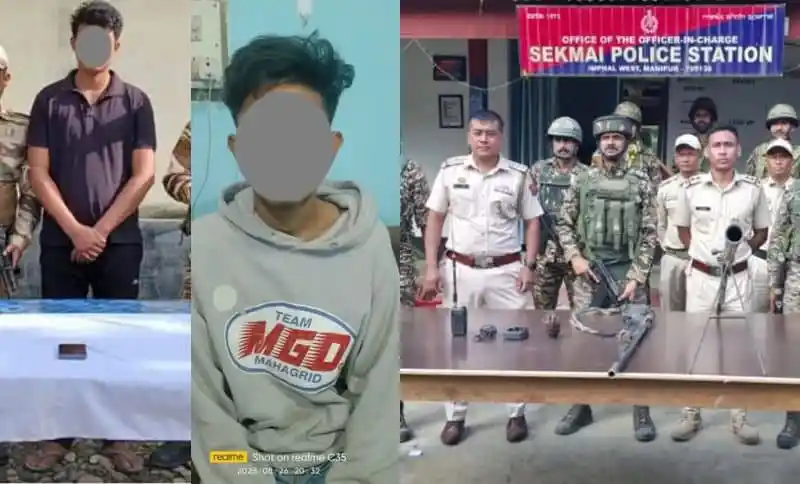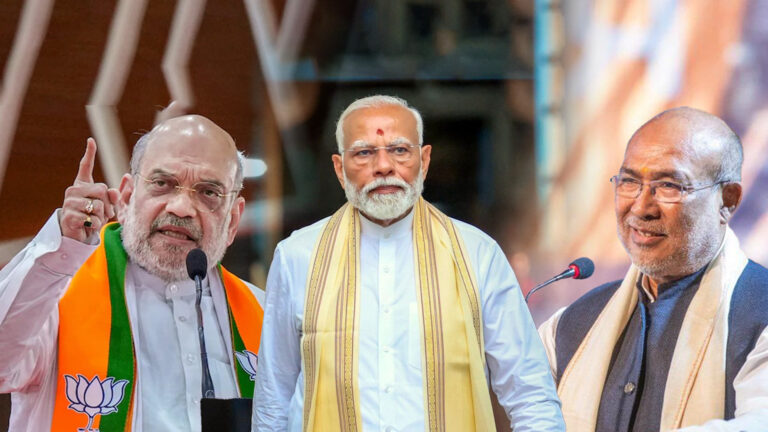Manipur: Two UG Cadres Arrested, Arms & Explosives Recovered
On August 28, 2025, Manipur Police, working with central forces, arrested two active underground (UG) cadres — Suraj Oinam (alias Chingkhomba/Abungo, 23) of the proscribed KCP (PWG) and Sarangthem Ibomcha Meitei (alias Luwangba, 22) of the banned KYKL — during separate operations in Imphal. Following interrogations, a third raid recovered weapons and explosives in Khongnangpokpi: a pompi (locally made) gun, a country-made rifle, one HE No.36 grenade, a radio handset and charger. Investigations are ongoing.
Key takeaways —
- Two active UG cadres were arrested in Imphal on August 28, 2025: Suraj Oinam (aka Chingkhomba/Abungo, 23) and Sarangthem Ibomcha Meitei (aka Luwangba, 22).
- The arrests were part of coordinated operations between Manipur Police and central security forces.
- Follow-up searches after interrogation led to the recovery of one pompi gun (locally made), one country-made rifle, one HE No.36 grenade, one radio handset and a charger in Khongnangpokpi.
- The arrested individuals are linked to KCP (PWG) and KYKL, both groups with histories in Manipur’s insurgent landscape.
- Authorities say investigations are continuing; this is part of a broader pattern of intensified operations across Manipur
The operation — a step-by-step reconstruction
Let’s walk through the timeline like a short crime drama: who, where, and what.
Step A — First pick-up (Canchipur, Singjamei Police Station area): Security teams arrested Suraj Oinam, identified as an active cadre of KCP (PWG), from the Canchipur area under Singjamei police limits. That arrest appears to have been intelligence-led — either a tip or prior surveillance — and targeted someone the forces already had under watch.
Step B — Second pick-up (Itham Wangma Mayai Leikai, Thoubal Dam Police Station area): A separate raid captured Sarangthem Ibomcha Meitei, an active cadre of KYKL, at his home. Officials recovered a mobile phone — a tiny but crucial breadcrumb that often cracks networks open during interrogation.
Step C — Follow-up raid (Khongnangpokpi, Sekmai Police Station area): After questioning, teams conducted another operation that recovered the weapons cache: mainly locally made weapons (a “pompi” gun), a country-made rifle, and an HE No.36 grenade. Radios and chargers were also found — evidence the cadres used communications gear to coordinate.
Weapons recovered — why the items matter
On paper, a “country-made rifle” and a radio handset sound unspectacular. In context, they can be dangerous.
- Pompi/pumpi (locally made) guns: These are improvised firearms or mortars manufactured locally in conflict zones. They vary in lethality — some are crude single-shot rifles, others function as improvised mortars — but they’re abundant, inexpensive, and hard to interdict because they are made from readily available materials. Their presence indicates both local supply chains for weapons and technical improvisation by cadres.
- Country-made rifles: Often single-barrel, locally fabricated firearms used widely across northeastern India. They represent grassroots-level armament, easier to procure than military-grade weapons but effective in close encounters.
- HE No.36 grenade: The No.36 (Mills bomb lineage) is a known fragmentation grenade type still referenced in South Asian arsenals. Finding a live HE No.36 grenade is serious — it’s an anti-personnel explosive with lethal fragmentation. This elevates the seizure from a small-arms cache to one with potential for mass harm. Handling, transport, and disposal become immediate priorities for EOD teams
- Radio handset & charger: Not glamorous, but critical. Radios show that these units were using direct communications — the old “walkie-talkie” approach — which can be short-range but very effective in coordinating small-cell operations and ambushes. Recovering them often helps map networks, call signs, and contact lists.
FAQs
Q1 — Were the arrested cadres charged immediately?
A1 — The publicly available report states they were arrested and interrogations led to follow-up raids; official charge sheets and formal FIR details typically follow after preliminary investigation and evidence collection. For specifics, check the Manipur Police release or subsequent court records.
Q2 — What exactly is a “pompi” (or “pumpi”) gun?
A2 — A “pompi” or “pumpi” refers to locally made improvised firearms or mortars used in northeast India. They are produced from common materials and can vary widely in lethality; their prevalence shows local adaptability in weapon production
Q3 — Is KYKL the same as KCP?
A3 — No. KYKL (Kanglei Yawol Kanna Lup) and KCP (Kangleipak Communist Party) are distinct organisations with different origins, though both operate within Manipur’s insurgent ecosystem. Both have been proscribed at various times and have histories of militant activity.
Q4 — Could these arrests spark retaliation or local unrest?
A4 — Any arrest of active cadres carries that risk; however, security forces often increase patrols and community outreach after operations to prevent escalation. Monitor official advisories and trusted local news.
Q5 — What does an HE No.36 grenade mean operationally?
A5 — The No.36 grenade is a fragmentation hand grenade design (Mills bomb lineage). Recovering a live HE No.36 is significant because of its potential to cause mass casualties; it requires EOD action and raises concerns about where the explosive was sourced.




